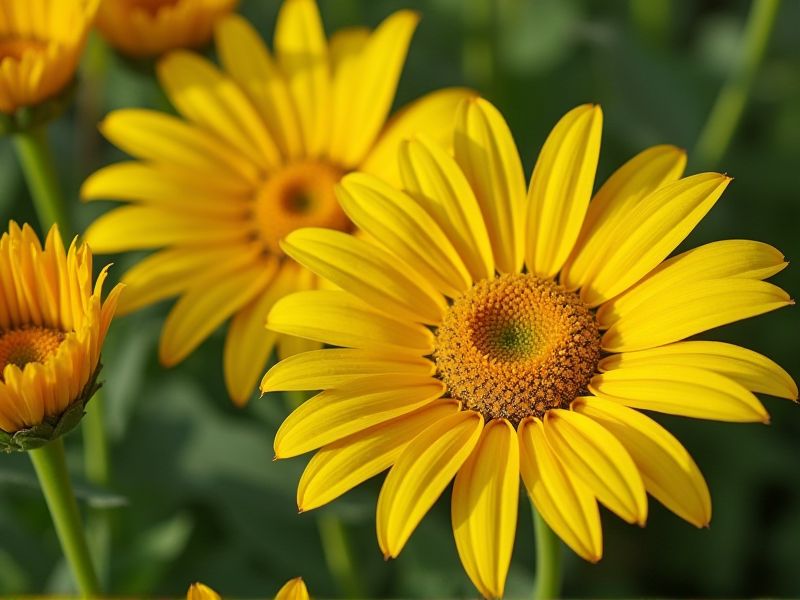
Sun-loving plants that are native to various regions thrive in bright, direct sunlight, making them ideal for gardens and landscapes with ample sunlight exposure. Some popular native options include the vibrant Echinacea purpurea, commonly known as purple coneflower, which attracts pollinators like bees and butterflies, enhancing biodiversity. Another excellent choice is Asclepias tuberosa, or butterfly weed, which blooms with bright orange flowers and serves as a host plant for monarch caterpillars. These native species not only require less water and maintenance but also support local ecosystems by providing habitat and food for wildlife. When selecting sun-loving plants, consider your specific region's native varieties to promote a sustainable and resilient garden.
List of some Sun-loving plants that are native
- Black-Eyed Susan (Rudbeckia hirta)
- Purple Coneflower (Echinacea purpurea)
- Butterfly Weed (Asclepias tuberosa)
- Lanceleaf Coreopsis (Coreopsis lanceolata)
- Indian Blanket (Gaillardia pulchella)
- Showy Goldenrod (Solidago speciosa)
- Blazing Star (Liatris spicata)
- Bee Balm (Monarda didyma)
- New England Aster (Symphyotrichum novae-angliae)
- Blanketflower (Gaillardia aristata)
Important things about Sun-loving plants that are native
Ideal Growing Conditions.
Sun-loving plants thrive in bright, direct sunlight, ideally requiring at least six hours of sun exposure daily. Native species, such as coneflowers and black-eyed Susans, excel in these conditions by adapting to local soil types and climate, ensuring they efficiently utilize sunlight for optimal growth. Proper watering in well-drained soil helps maintain their health, as these plants prefer a balance of moisture without becoming waterlogged. By incorporating these native sun-loving plants into your garden, you foster a vibrant ecosystem that supports local pollinators and enhances biodiversity.
Drought Resistance.
Sun-loving plants that are native to arid regions exhibit remarkable drought resistance, making them ideal for low-water landscapes. Species like the Agave americana and the Echinocereus triglochidiatus have adapted to minimize water loss through specialized structures like thick leaves and deep root systems. These resilient plants not only thrive in bright sunlight but also contribute to local biodiversity by supporting various pollinators. Incorporating native drought-resistant plants in your garden can reduce water consumption while enhancing the natural beauty of your outdoor space.
Attracts Pollinators.
Sun-loving plants that are native to your region play a vital role in attracting pollinators such as bees, butterflies, and hummingbirds. Species like the Purple Coneflower (Echinacea purpurea) and Black-eyed Susan (Rudbeckia hirta) thrive in full sunlight, providing vibrant blooms that serve as a nectar source. These plants not only enhance the beauty of your garden but also support local ecosystems by fostering biodiversity. Incorporating native sun-loving plants into your landscape can lead to healthier pollinator populations and promote sustainable gardening practices.
Adapted Root Systems.
Sun-loving native plants have adapted root systems that effectively support their survival in low-water environments. These root systems often penetrate deeply into the soil, allowing access to moisture and nutrients that are otherwise unavailable to shallow-rooted species. This adaptability not only enhances their resilience against drought but also helps stabilize soil, reducing erosion. By selecting native sun-loving plants for your garden, you can promote biodiversity while utilizing their natural adaptations for a sustainable landscape.
Seasonal Blooming.
Sun-loving plants native to various regions showcase vibrant seasonal blooms, enhancing gardens and landscapes. Examples include the California poppy, with its bright orange petals, thriving in full sun and promoting local biodiversity. Another favorite, the coneflower, attracts pollinators while showcasing a range of colors from purple to white, perfect for summer gardens. By selecting these native sun-loving plants, you can create a visually stunning and environmentally friendly outdoor space.
Low Maintenance.
Sun-loving plants native to your region typically require minimal care while adding vibrancy to your garden. Examples include the hardy black-eyed Susan, which blooms with bright yellow petals, and the drought-resistant lavender, known for its fragrant, purple flowers. You can also consider planting goldenrod, a nectar-rich option that attracts pollinators and thrives in full sunlight. These native varieties not only beautify your space but also support local ecosystems by providing habitats and food sources for wildlife.
Soil Preferences.
Sun-loving native plants thrive in well-drained soil with a neutral to slightly acidic pH, making them ideal for sunny gardens or landscapes. These plants, such as Echinacea purpurea (Purple Coneflower) and Rudbeckia hirta (Black-eyed Susan), not only enhance biodiversity but also attract pollinators like bees and butterflies. You can improve soil drainage by incorporating organic matter, ensuring that these sun-loving species flourish in their natural environment. Choosing the right native plants for your garden not only supports local wildlife but also contributes to sustainable landscaping practices.
Wildlife Habitat Support.
Sun-loving native plants, such as Echinacea purpurea (Purple Coneflower) and Rudbeckia hirta (Black-eyed Susan), thrive in open habitats and provide essential nourishment for local wildlife. These plants not only attract pollinators like bees and butterflies but also serve as a food source for birds and other creatures. Incorporating these species into your garden can enhance biodiversity while creating a vibrant landscape. By choosing native sun-loving plants, you contribute to the conservation of the local ecosystem and support the wildlife that depends on these habitats.
Ecological Benefits.
Sun-loving native plants play a crucial role in local ecosystems by providing habitats for various wildlife, including pollinators such as bees and butterflies. These plants are well-adapted to local soil and climate conditions, requiring less water and maintenance, which promotes sustainable gardening practices. Their deep-root systems help prevent soil erosion and improve soil health by enhancing nutrient cycling. By incorporating sun-loving native plants into your garden, you contribute to biodiversity and support the overall resilience of your local environment.
Regional Climate Adaptability.
Sun-loving plants native to your region exhibit remarkable adaptability to local climate conditions, thriving in full sunlight and well-drained soils. These plants, such as native wildflowers and succulents, are not only drought-tolerant but also support local wildlife, including pollinators like bees and butterflies. By incorporating these species into your garden, you contribute to biodiversity while ensuring reduced water usage and maintenance. Understanding their growth habits and seasonal behavior can enhance your landscape, making it both beautiful and environmentally sustainable.
